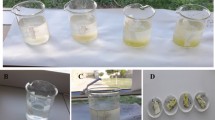Abstract
A method was tested for growing aquatic vascular plants at elevated hydrostatic pressure so that the influence of other factors will not mask the specific plant-pressure interaction.
Eighteen species of submersed vascular plants, belonging to twelve families and several distinct growth forms, were subjected to series of hydrostatic pressures including those well in excess of those encountered by the species when growing at its normal depths in lakes. Under no circumstances was the form of the plant altered even at the highest pressures, equivalent to that at a water depth of 23 m. The removal of confounding extraneous factors depends upon controlling competing algae, on raising the pressure in a series of steps, on maintaining the pressure without fluctuations during the growing period, on suiting the light and temperature conditions to the species and maintaining aquasoil air spaces or allowing them to develop.
These preliminary data suggest that the level of hydrostatic pressure in the depth distribution of aquatic plants cannot be either a necessary or a sufficient controlling factor.
Similar content being viewed by others
References
Bodkin, P. C., U. Posluszny & H. M. Dale, 1980. Light and pressure in two freshwater lakes and their influence on the growth, morphology and depth limits of Hippuris vulgaris. Freshwater Biology 10: 545–522.
Craig, S. R., 1976. Seasonal development of structure in two macrophyte communities in Lake Opinicon, Ontario. M.Se. thesis, Queen's University, Kingston. 103 pp.
Dale, H. M., 1981. Hydrostatic pressure as the controlling factor in the depth distribution of Eurasian watermilfoil Myriophyllum spicatum L. Hydrobiologia 79: 239–244.
Denny, P., 1971. Zonation of aquatic macrophytes around Habukara Island, Lake Bunyonyi, S.W. Uganda. Hidrobiologia, Bucuresti 12: 249–257.
Denny, P., 1973. Lakes of south-western Uganda. II. Vegetation studies on Lake Bunyonyi. Freshwater Biol. 3: 123–135.
Ferling, E., 1957. Die Wirkungen des erhohten hydrostatischen Druckes auf Wachstumuand Differenzierung submerser Blutenpflanzen. Planta 49: 235–270.
Gessner, F., 1952. Der Druck in seiner Bedeutung fur das Wachstum submerser Blutenpflanzen. Planta 40: 391–397.
Gessner, F., 1955. Hydrobotanik: Die Physiologischen Grundlagen der Pflanzenverbreitung in Wässer l: Energiehaushalt, Berlin, VEB Deutscher Verlag der Wissenschaften. 517 pp.
Gessner, F., 1961. Hydrostatischer Druck and Pflanzenwachstum.. In W. Ruhlan (ed.), Encyclopedia of Plant Physiology. Berlin. plSpringer-Verlag. 16: 668–690.
Hoagland, D. R.& D. 1. Arnon, 1950. The water culture method of growing plants without soil. Calif. Agr. Sta. Circ. 347.
Hongve, D., 1975. The littoral vegetation of Nordbytjernet, a small lake in south-east Norway. Norw. J. Bot. 22: 83–97.
McLaughlin, E. G., 1974. Autecological studies of three species of Callitriche native in California. Ecological Monographs 44: 1–16.
Natelson, D., 1954. The phytosociology of submerged aquatic macrophytes in Wisconsin lakes. Ph.D. thesis, University of Wisconsin.
Nygaard, G., 1958. On the productivity of the bottom vegetation in Lake Grane Langso. Verb. Internat. Ver Limnol. 13: 144–155.
Schmid, W. D., 1965. Distribution of aquatic vegetation as measured by line intercept with SCUBA. Ecology 46: 816–823.
Sheldon, R. B. & C. W. Boylen, 1977. Maximum depth inhabited by aquatic vascular plants. Amer. Midl. Nat. 97: 248–254.
Spence, D. H. N., 1967. Factors controlling the distribution of fresh water macrophytes with particular reference to the lochs of Scotland. J. Ecol. 55: 147–170.
Spence, D. H. N., 1974. Light on freshwater macrophytes. Trans. Bot. Soc. Edinb. 41: 491–505.
Spence, D. H. N., 1976. Light and plant response in fresh water. In G. C. Evans, R. Bainbridge & O. Rackham (eds.), Light as an Ecological Factor. II. 16th Symp. British Ecological Soc., pp. 93–133.
Spence, D. H. N. & H. M. Dale, 1978. Variations in the shallow water form of Potamogeton richardsonii induced by some environmental factors. Fresh. Biol. 8: 251–268.
Wetzel, R. G. & D. L. McGregor, 1968. Axenic culture and nutritional studies of aquatic macrophytes. The American Midland Naturalist 80: 52–64.
Wilson, L. R., 1941. The larger aquatic vegetation of Trout Lake, Vilas County, Wisconsin. Trans. Wisc. Acad. Sci. Lett. 33: 133–146.
Author information
Authors and Affiliations
Rights and permissions
About this article
Cite this article
Dale, H.M. Hydrostatic pressure and aquatic plant growth: a laboratory study. Hydrobiologia 111, 193–200 (1984). https://doi.org/10.1007/BF00007199
Received:
Accepted:
Issue Date:
DOI: https://doi.org/10.1007/BF00007199




